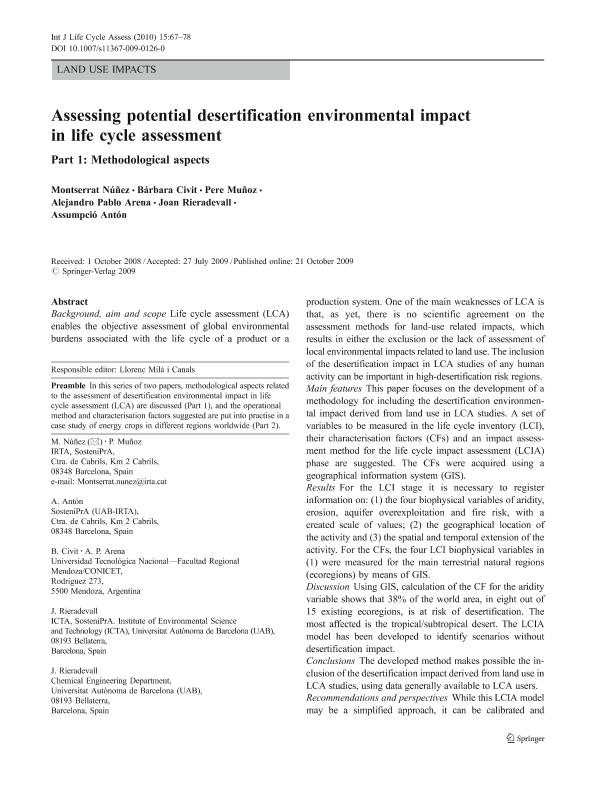Artículo
Assessing potential desertification environmental impact in life cycle assessment: Part 1: Methodological aspects
Nuñez, Montserrat; Civit, Bárbara María ; Muñoz, Pere; Arena, Alejandro Pablo
; Muñoz, Pere; Arena, Alejandro Pablo ; Rieradevall, Joan; Antón, Assumpció
; Rieradevall, Joan; Antón, Assumpció
 ; Muñoz, Pere; Arena, Alejandro Pablo
; Muñoz, Pere; Arena, Alejandro Pablo ; Rieradevall, Joan; Antón, Assumpció
; Rieradevall, Joan; Antón, Assumpció
Fecha de publicación:
01/2010
Editorial:
Springer Heidelberg
Revista:
International Journal Of Life Cycle Assessment
ISSN:
0948-3349
Idioma:
Inglés
Tipo de recurso:
Artículo publicado
Clasificación temática:
Resumen
Background, aim and scope: Life cycle assessment (LCA) enables the objective assessment of global environmental burdens associated with the life cycle of a product or a production system. One of the main weaknesses of LCA is that, as yet, there is no scientific agreement on the assessment methods for land-use related impacts, which results in either the exclusion or the lack of assessment of local environmental impacts related to land use. The inclusion of the desertification impact in LCA studies of any human activity can be important in high-desertification risk regions. Main features: This paper focuses on the development of a methodology for including the desertification environmental impact derived from land use in LCA studies. A set of variables to be measured in the life cycle inventory (LCI), their characterisation factors (CFs) and an impact assessment method for the life cycle impact assessment (LCIA) phase are suggested. The CFs were acquired using a geographical information system (GIS). Results: For the LCI stage it is necessary to register information on: (1) the four biophysical variables of aridity, erosion, aquifer overexploitation and fire risk, with a created scale of values; (2) the geographical location of the activity and (3) the spatial and temporal extension of the activity. For the CFs, the four LCI biophysical variables in (1) were measured for the main terrestrial natural regions (ecoregions) by means of GIS. Discussion: Using GIS, calculation of the CF for the aridity variable shows that 38% of the world area, in eight out of 15 existing ecoregions, is at risk of desertification. The most affected is the tropical/subtropical desert. The LCIA model has been developed to identify scenarios without desertification impact. Conclusions: The developed method makes possible the inclusion of the desertification impact derived from land use in LCA studies, using data generally available to LCA users. Recommendations and perspectives: While this LCIA model may be a simplified approach, it can be calibrated and improved for different case studies. The model proposed is suitable for assessing the desertification impact of any type of human activity and may be complemented with specific activity indicators, and although we have considered biophysical factors, the method can be extended to socio-economic vectors.
Archivos asociados
Licencia
Identificadores
Colecciones
Articulos(INCIHUSA)
Articulos de INST. DE CS. HUMANAS, SOC. Y AMBIENTALES
Articulos de INST. DE CS. HUMANAS, SOC. Y AMBIENTALES
Citación
Nuñez, Montserrat; Civit, Bárbara María; Muñoz, Pere; Arena, Alejandro Pablo; Rieradevall, Joan; et al.; Assessing potential desertification environmental impact in life cycle assessment: Part 1: Methodological aspects; Springer Heidelberg; International Journal Of Life Cycle Assessment; 15; 1; 1-2010; 67-78
Compartir
Altmétricas
Items relacionados
Mostrando titulos relacionados por título, autor y tema.
-
Civit, Bárbara María ; Arena, Alejandro Pablo ; Nuñez, Monserrat; Muñoz, Pere; Antón, Assumpció; Rieradevall, Joan (Springer Heidelberg, 2013-08-04)



